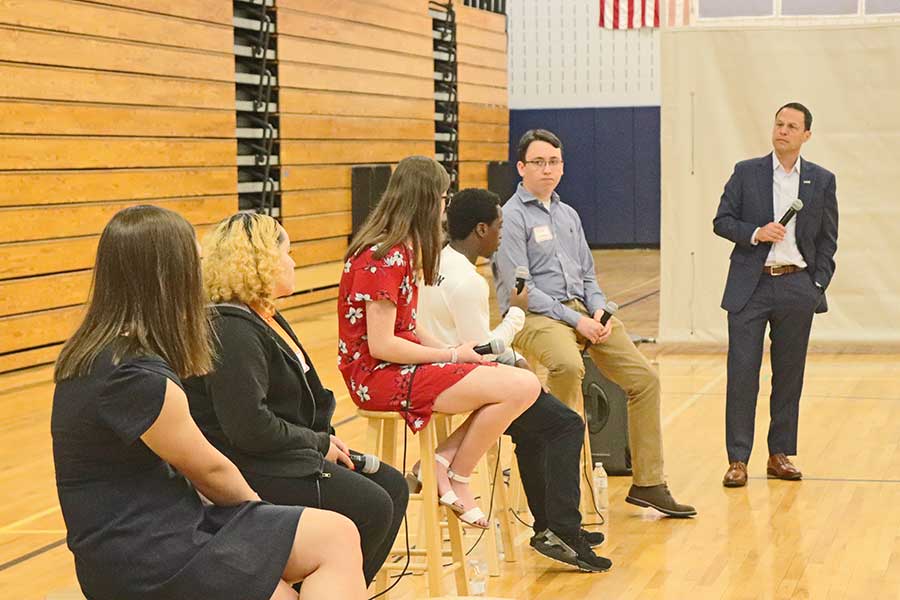Pennsylvania’s Office of Attorney General released a resource guide in October for students, guardians and educators about bullying prevention and intervention for National Bullying Prevention Month.
It offers insights from student conversations, called “TeenTALK sessions,” that occurred during the 2018-19 school year. Representatives from 13 districts, including Allentown, East Penn, Harrisburg and Downingtown participated.
The TeenTALK report indicated 70 percent of LGBTQ students were verbally bullied or harassed due to their sexual orientation, and 59 percent reported being bullied or harassed because of their gender expression. The report also said that LGBTQ students are three times more likely to experience bullying and four times more likely to be cyberbullied than non-LGBTQ students.
“Bullying is a pervasive issue affecting students across the Commonwealth — one-fifth of Pennsylvania students aged 12-18 are bullied on school property each year, and bullying disproportionately targets students of color, students with disabilities and members of the LGBTQ community,” Attorney General Josh Shapiro said.
Mike Makhoul, principal of Dieruff High School in Allentown, which participated in TeenTALK along with three other Lehigh Valley Schools, said, “Oftentimes in urban schools, there’s a misperception about the challenges that our students face versus students from other demographics or other types of cultures and climates or schools or more affluent districts. But it was great to see that our kids deal with the same challenges as all kids throughout the Lehigh Valley, and that they were united in that front of caring and wanting to change the struggles that they face. They really took over that conversation and talked about the mental health needs that their generation currently faces.”
This echoes the TeenTALK report’s findings that showed students indicated mental health services, staffing, data report gaps and funding should be addressed to further prevent bullying. The AG’s recommendations include better reporting channels, training for staff and consistent policies that address cyberbullying, bullying and harassment.
This generation of students faces different challenges than those before them, Shapiro said.

“I never had to face issues in school like cyberbullying or gun violence,” he added. “Young people and, especially, LBGTQ youth are facing enormous obstacles beyond homework, test scores and what they plan to do after high school. The more open we can be with them and communicate about these obstacles, the more we will be able to learn and help them healthfully confront these real challenges.”
Makhoul supported Shapiro’s statement and indicated he sees social media and “the cyber component” spilling into the hallways at Dieruff. “People are very quick to judge and react and respond to things online but then the conflict navigation of that decision-making process plays itself out in person with some aggression, some hostility, misconstruing of things said or done online, and then we have problems in school,” he said.
The Human Rights Campaign found that 92 percent of LGBT youth report hearing negative messages about being LGBT, primarily from school, peers and the internet.
“I know a lot of people [who are LGBT], and to be honest, there’s nothing really different from them and me,” said Hezekiah Johnson, a fourth-year student at Dieruff High School. “We’re the same thing. We’re just people.”
Makhoul said Dieruff has “several built-in multi-tiered systems of support for [LGBTQ] students, including a gay-straight alliance “that comes together and meets on a regular basis.” He said the group is heavily involved in the community, helps raise awareness and is “part and parcel of our school.”
In January, the attorney general’s office implemented Safe2Say Something, an anonymous reporting system in partnership with educational nonprofit Sandy Hook Promise. Via phone, email and an app, students, teachers, administrators and staff can report unsafe activities happening in schools. In its first six months, the app received 25,000 tips, Shapiro said.
“When we launched the commonwealth’s Safe2Say Something program, we thought the tips shared with us would mostly be about violence, but what we are realizing is that the tips are mostly about mental health, suicide, etcetera,” he added. “We had to adjust our calculation and our work based on that. We feel we have been successful, but there is always room to improve.”
Safe2Say Something came after Governor Wolf signed a 2018 law that allowed Pennsylvania to become the first state to mandate that schools have an anonymous tip line to report school safety concerns. In TeenTALK sessions, students said the app was an effective way to bring concerns forward.
The technology showed Makhoul how much students care and look out for each other.
“They know what to look for, and we’ve invested a lot of time in coaching them up on what to report and how to report, and they’ve risen to the occasion and to the call.”
He said if students provide any type of identifiable information about a student in need, “we immediately triage,” adding, “What I like about it is it gives us a direct platform for kids to anonymously report concerns.”
But Makoul said there’s more work to be done.
“The public education system needs community connections, particularly in the urban sectors,” he added. “We don’t have enough of the resources to do this very difficult, challenging, yet essential work on our own.”
